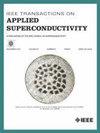Mechanical Simulation of 2G HTS Tapes and Stacks During Localized Temperature Increase
IF 1.7
3区 物理与天体物理
Q3 ENGINEERING, ELECTRICAL & ELECTRONIC
引用次数: 0
Abstract
High-temperature superconductor (HTS) materials have emerged as promising candidates for high-field magnets due to their superior critical current density, temperature, and magnetic fields. During magnet quench, high current density can quickly lead to local temperature increase and temperature gradient that can potentially damage the coil. This paper presents an analysis of the mechanical impact of the large thermal gradients. The study employs 3D finite element method (FEM) simulations to investigate the mechanical responses of second-generation HTS tapes to different hotspot temperature profiles. The focus is on analyzing the axial tape strain, normal stress and the various shear stresses in tape layer interfaces. We consider both single tapes and tape stacks. The normal zone propagation is not simulated, but we examine different end-temperature profiles to identify the critical thermal conditions that may lead to too large strain or stress. The results suggest that induced axial strain can exceed the elastic limit or lead to irreversible critical current reduction. Also, the shear stress computed using the Mohr-Coulomb criterion may reach very high values potentially leading to mixed-mode delamination. Future studies are needed to verify the damage methods after high temperatures and help in determining the maximum safe temperature in magnet design. The results highlight the importance of mechanical boundary conditions in this type of numerical or experimental study.局域升温过程中2G高温超导带和堆的力学模拟
高温超导体(HTS)材料由于其优越的临界电流密度、温度和磁场而成为高磁场磁体的有希望的候选者。在磁体淬火过程中,高电流密度会迅速导致局部温度升高和温度梯度,这可能会损坏线圈。本文对大热梯度的力学影响进行了分析。采用三维有限元法(FEM)模拟研究了第二代高温超导胶带在不同热点温度分布下的力学响应。重点分析了带层界面的轴向带应变、法向应力和各种剪切应力。我们同时考虑单个磁带和磁带堆。正常区域的扩展没有模拟,但我们检查了不同的端温分布,以确定可能导致过大应变或应力的临界热条件。结果表明,诱导轴向应变可以超过弹性极限或导致不可逆的临界电流减小。此外,使用莫尔-库仑准则计算的剪切应力可能达到非常高的值,可能导致混合模式分层。需要进一步的研究来验证高温后的损伤方法,并帮助确定磁体设计中的最高安全温度。结果强调了力学边界条件在这类数值或实验研究中的重要性。
本文章由计算机程序翻译,如有差异,请以英文原文为准。
求助全文
约1分钟内获得全文
求助全文
来源期刊

IEEE Transactions on Applied Superconductivity
工程技术-工程:电子与电气
CiteScore
3.50
自引率
33.30%
发文量
650
审稿时长
2.3 months
期刊介绍:
IEEE Transactions on Applied Superconductivity (TAS) contains articles on the applications of superconductivity and other relevant technology. Electronic applications include analog and digital circuits employing thin films and active devices such as Josephson junctions. Large scale applications include magnets for power applications such as motors and generators, for magnetic resonance, for accelerators, and cable applications such as power transmission.
 求助内容:
求助内容: 应助结果提醒方式:
应助结果提醒方式:


